About herding in general
How it started...
Herding as a hobby was started in 1998 by a number of enthusiastic breeders of Hungarian herding dogs. They were aware that our beloved herding breeds are different from other, similar looking breeds, mainly due to their mental and herding capabilities. These attributes are worthy of our attention!
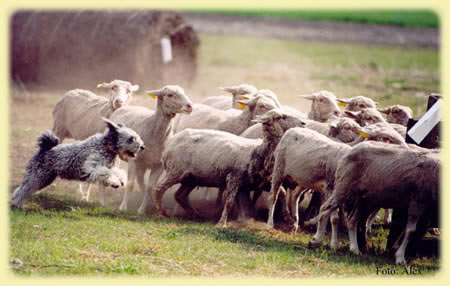
These breeders started organizing herding trials and instinct tests, and not for naught! Many dogs who were city dwellers and never saw sheep (except maybe on TV…) knew right away what to do with a flock of sheep.
These capability tests, which were previously called instinct tests, reflected very well the abilities still present in the breeds. These tests played a role in the preservation of the behavioral characteristics which slowly gained more emphasis among the breeders.
My hope is that this trend continues and besides conformation, the working ability, with the indispensible mental capabilities, stable nervous system and anatomically correct physique will take at least as high a priority as obtaining a breed championship. Only this way can our breed, the Pumi, with its extremely valuable qualities be well-rounded.
Herding, past and present
The role of tradition in today’s herding
The working style of our present day dogs is the result of centuries of selection by shepherds. This became a tradition passing from father to son. The selection was directed towards performing tasks which were based on the uniqueness of the Carpathian Basin. There were no huge contiguous pastures, but many smaller ones, which were accessible only by narrow roads, through woods, cultivated fields and strip parcels.
A 100-200 head Hungarian Grey cattle herd or 1000-1500 head of sheep had to be driven within these confines without the livestock damaging various parcels belonging to different owners. This was a very trying chore for a person.
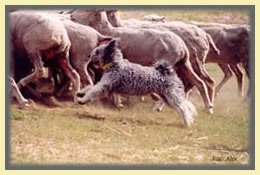 There was a need for a fast, spirited, decisive dog, capable of completing a task independently; one who is perfectly capable of assessing the given situation and to make decisions – correctly - because of its strong desire to please. It’s not afraid to get close to livestock, but at the same time is absolutely trustworthy and doesn’t damage the livestock.
There was a need for a fast, spirited, decisive dog, capable of completing a task independently; one who is perfectly capable of assessing the given situation and to make decisions – correctly - because of its strong desire to please. It’s not afraid to get close to livestock, but at the same time is absolutely trustworthy and doesn’t damage the livestock.
Such is the Pumi.
The selection was radical: a dog that didn’t fulfill these requirements could not live with the shepherd. Only these criteria existed for the selection. Shepherds didn’t care about the dog’s looks.
Today we have no other task but to utilize these uncommon qualities with some care and preserve them in the breed. Teaching herding is based on the dog’s abilities shaped to our own requirements. That’s why it pays to take into consideration the centuries old traditions still at work!
The herding dog’s uniqueness
Herding itself is a big challenge for the Pumi, as well as for the shepherd. In the past, the shepherds used their dogs to drive the stock to and from the pasture and to separate individual sheep from the flock. Driving the flock to a farther pasture could only be accomplished with a dog who could be directed accurately. It was a difficult task to drive 500 sheep on a narrow road between two wheat fields in such way that the sheep won’t go into the wheat, which is very attractive to them.
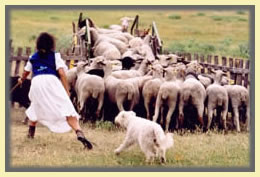 Generally the flock went ahead of the shepherd and the dog went where he was needed. If the flock had to turn to some direction, the shepherd sent the dog to the front of the flock and turned it in the desired direction. Or, if needed, the dog just stopped the flock or simply drove it from the rear. The toughest task was always driving the flock across a bridge or a brook. Livestock won’t go willingly over unfamiliar obstacles like these.
Generally the flock went ahead of the shepherd and the dog went where he was needed. If the flock had to turn to some direction, the shepherd sent the dog to the front of the flock and turned it in the desired direction. Or, if needed, the dog just stopped the flock or simply drove it from the rear. The toughest task was always driving the flock across a bridge or a brook. Livestock won’t go willingly over unfamiliar obstacles like these.
Some more experienced Pumik were capable of selecting the rams from the flock one by one (rams have a different, stronger odor than ewes, the dogs most likely distinguished between them based on this).
Herding work basically consists of collecting and driving. Collecting was needed when the dog had to collect the flock which was spread over the pasture, and drive it back to the shepherd.
In this occasion the flock was between the shepherd and the dog. When driven, the livestock went in the front, behind them the dog; the shepherd walked in the rear, and when he had to, he sent the dog where it was needed.
Driving on the side of the road was a daily chore in the past. The dog had to keep the sheep on one side of the road – by himself - to prevent them from blocking the road. He had to push the sheep that were sticking out, back into the flock; this was called “edging”.
We could list some more difficult tasks, but these few should give the sense that a good herding dog is indispensible and even today it does the work of several people in sheep farms.
It doesn’t expect more than a little love in exchange, but sometimes it gets very little of that, although all shepherds hold a good dog in high esteem.
According to old-time professional shepherds these are the characteristics of a good dog: it should work day and night, and in the cold or heat if necessary. The heat is especially very hard on the dog, as well as on the shepherds. The shepherds don’t like a dog that lies down in the shade and has to be persuaded to run after the sheep. Such a dog is not going to be long-lived with the shepherd. It should bark until it’s hoarse, should run - often many kilometers – after the flock and drive the sheep back to the shepherd by itself. If the dog fulfills these requirements, the shepherd will share his food with it.
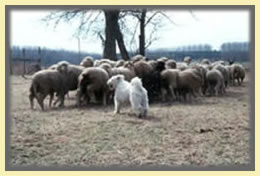 Border Collies, a breed originating from the Scottish-English border region perform classical balanced gathering work. For this breed, driving is a much more difficult chore. They gather the sheep with instinctive balance, which means that they always try to place themselves on the opposite side of the flock in relationship to the shepherd. This balancing-gathering work is present in the Pumi in a slightly different form, but the Pumi’s connection with their owner is much stronger than with the sheep, thereby they respond better to the directions given by their owner, rather than to their own balancing instinct. The essence of balance is keeping the sheep in place, which is dealt with by the Pumi independently by running lightning-fast around the sheep several times, assuring the sheep can’t break out and escape in any direction.
Border Collies, a breed originating from the Scottish-English border region perform classical balanced gathering work. For this breed, driving is a much more difficult chore. They gather the sheep with instinctive balance, which means that they always try to place themselves on the opposite side of the flock in relationship to the shepherd. This balancing-gathering work is present in the Pumi in a slightly different form, but the Pumi’s connection with their owner is much stronger than with the sheep, thereby they respond better to the directions given by their owner, rather than to their own balancing instinct. The essence of balance is keeping the sheep in place, which is dealt with by the Pumi independently by running lightning-fast around the sheep several times, assuring the sheep can’t break out and escape in any direction.
This is also called the “holding” instinct. In fact, this is the herding instinct itself, or the “compulsion” of keeping the flock together. If the dog does anything else with the flock, forces a sheep to break out or cuts into the flock, scatters and chases them, we’re talking about completely different instincts…
Here in the Carpathian Basin traditional herding is widespread; our herding dogs are equally comfortable gathering and driving. Their working style is characteristically different from the so-called English style work of the Border Collie or the Australian Kelpie. Our dogs are spirited, with lightning-fast movement and they don’t like to keep distance from the livestock.
Traditional work
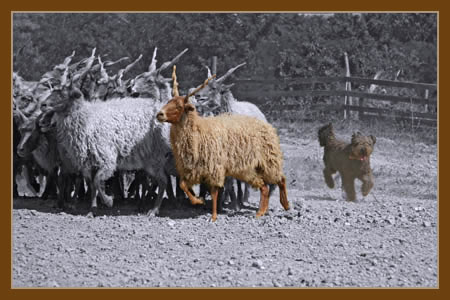
The most commonly found task in traditional herding work was driving the stock to the pasture and back. This was not very simple with 200 heads of Grey Cattle or with 1000-1500 sheep, especially when we consider how hard it is to start moving this many animals or to stop them. If 1500 sheep start moving, they have so much mass and energy in motion, that a real tough and fast dog was needed. This toughness occasionally included disciplining recalcitrant stock for educational purposes. If the dog didn’t do this, it could happen that the stock didn’t respect the dog and sensing its weakness, would turn on it and chase it away. Or let’s consider a 1600 pound Hungarian Grey: it wouldn’t be much impressed with the little barking and jumping silver flea if it doesn’t grab hard!
This is the reason that it’d be almost impossible to ask the dog to keep distance from the stock, and so far nobody was successful doing this. One thing was as important then as now: the dog couldn’t bite the stock without a reason. Other occasional tasks shepherds encountered were guarding the flock, shedding individuals from the flock, driving stock onto a wagon and across a bridge. These elements can be found in hobby herding in the form of some exercises.
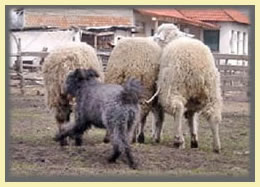 The most prominent difference between traditional and hobby herding work is that in hobby herding a smaller flock consisting of 10-30 head of sheep is more prevalent. It’s much harder for the high-strung, spirited dog to herd the small flock, as the sheep are not as cohesive as in a large herd and run considerably faster. However, the Pumi can be trained for this too!
The most prominent difference between traditional and hobby herding work is that in hobby herding a smaller flock consisting of 10-30 head of sheep is more prevalent. It’s much harder for the high-strung, spirited dog to herd the small flock, as the sheep are not as cohesive as in a large herd and run considerably faster. However, the Pumi can be trained for this too!
In hobby herding the field is much smaller and more difficult, because the sheep have to be moved in this small area through narrow obstacles. The basic elements of the traditional herding work can be found here, such as driving sheep out of the pen, and driving them back into it. The equivalent of moving the flock between pastures is the movement through the obstacles. A narrow opening could be the equivalent of driving onto a wagon or counting the sheep.
A calmer, less forceful dog may be an asset to hobby herding. This kind of herding is technically more difficult than traditional herding. It requires great concentration, discipline, practice and skill from the dog as well as from the handler. The dog has to obey many more commands in rapid succession to make the small flock wind its way accurately through the obstacles. This perhaps requires less independent work from the dog than when it has to bring home a flock from a pasture 2 miles away, all by itself.
In both traditional and hobby herding teamwork is essential, i.e. the shepherd helps the dog by placing himself in the right position or by urging the stock with his shepherd’s staff.
Hobby herding
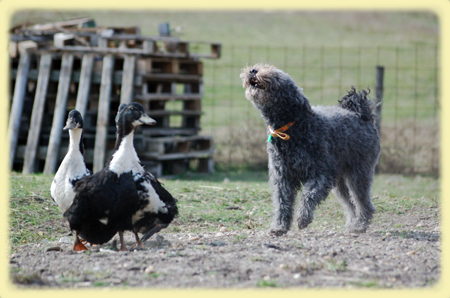
Herding itself is nothing else but keeping the sheep together and permitting it to move in a predetermined direction. To be specific, the sheep being a prey animal is always looking for an escape route. In herding we merely cut off the escape route with the dog, only leaving the stock a certain direction in which we want to move them.
This is a remarkably refined and complicated task, because every moment we have to think with many brains: ours, our dog’s and a herdful of livestock’s. This is a challenge, and now, in today’s stressful world we think about ways to tire out our dogs who are bursting with energy as they’re sitting at home bored – I dare to declare that the most effective way to do this is herding.
Hobby herding started over 10 years ago with a handful of enthusiasts. Nowadays it’s widely spreading as a favorite sport – or rather recreation. More and more people with herding breeds recognize this great opportunity.
There has been a vigorous reorganization process going on with the Hungarian herding trials in the last several years; as a result the herding trial regulations, training methods as well as the herding styles are diverging according to breed.
For example, in a country with completely different geographic makeup from that of Hungary, such as the United Kingdom, a dog developed with entirely different style, temperament and capabilities.
For sure there can be parallels, but it’s clear that a breed used to working in 50 degrees F, at distances of 30-60 feet and applying pressure on the livestock only with strong eyes can’t be used on our narrow parcels of land, with summer temperatures up to 104 degrees F. Most of the time the dog won’t even be seen crawling in the adjacent cornfield….
Or, let’s consider the extraordinary balancing instinct of the Border collie, which means that it instinctively moves to the opposite side of the livestock from us, thus cutting off their escape routes and keeping them together. With this, it pushes the stock towards us. If these animals happen to be semi-wild Grey Cattle, I would certainly not be grateful for my dog’s powerful balancing instinct!
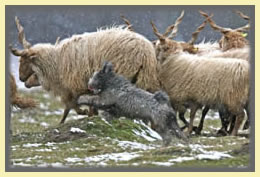 You can’t really convince the Pumi that it should advance very slowly around the livestock at a distance of 60-90 feet, only to look at them. As the distance between the Pumi and the stock increases, the contact between the dog and the stock it’s supposed to herd deteriorates in direct proportion; the dog gradually loses interest if we don’t let it get close to the stock because it feels that it’s not in control of the flock.
You can’t really convince the Pumi that it should advance very slowly around the livestock at a distance of 60-90 feet, only to look at them. As the distance between the Pumi and the stock increases, the contact between the dog and the stock it’s supposed to herd deteriorates in direct proportion; the dog gradually loses interest if we don’t let it get close to the stock because it feels that it’s not in control of the flock.
The physical proximity is very important to the dog, to be able to be in action every moment where it is needed!
The result of the reorganization is that the prospective herding enthusiasts slowly realized that the most productive is to expect from each breed the traditional attributes it was selected for.
See the sketch of a Hungarian style competition course here: >>
Herding instinct test
In the past the Hungarian shepherds selected and bred based on accomplishment oriented considerations. A great working dog’s reputation spread fast. Looks was barely important, only to the extent that the dog’s coat shouldn’t require too much maintenance and won’t be too long, so that thistle and thorns won’t stick in it, and if they do, they should come off easily – they were not supposed to bother the dog while working.
On sheep farms it happened frequently that the dog was sheared together with the sheep. In looks the herding dogs were heterogeneous; they could have been considered more mixed breeds than puli, mudi or pumi.
Unfortunately, nowadays we see the exact opposite: contemporary breeders - with a few exceptions - select only by looks. The Puli has almost fallen “victim” to this; the pumi and the mudi are not far behind…
Lately, attention to health started to play a role, but the behavioral characteristics, the nervous system, work and achievement are almost forgotten in these dogs, in spite of the fact that they were born to work! It should be very important for these ancient breeds to preserve their breed characteristics and tradition in their entirety; emphasizing the working ability, the looks and health as well. The duty and responsibility of the breeder is to cover these three, as they make the breed whole. Naturally, not only the breeder is responsible for these, but pumi buyers who don’t research whether the parents were inspected and how, whether they have any working achievements, whether they may have been screened for genetic diseases; but most of the time they’re not even inquiring about results of conformation shows.
Several conscientious breeders who recognized the importance of preserving these breeds’ excellent qualities, started a major initiative in the late 90’s: they started to organize herding trials and herding instinct tests. It would be great if more and more breeders selected work tested individuals for their breeding programs.
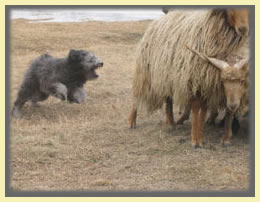 Herding instinct is an important gauge for the breeders for preserving not only their breeds’ conformation the the future generations. These dogs nowadays are tested for herding instinct by professionally trained judges. In the test the handler approaches the flock with the dog. Novice, undisciplined dogs are on the leash, more disciplined dogs can follow the handler off leash. The judges evaluate the dog’s instinct according to its behavior. As a result of the herding instinct test the dog can be rated “Satisfactory”, “Uncertain” or “Unsatisfactory”. Naturally, it’s not enough that the dog runs out in a direction, barks and returns when called – this by itself is not herding instinct. The dog has to be interested in the livestock. It is also not permissible that the dog is so interested that it separates a sheep from the flock and chases it. This is called shedding which comes from strong hunting instinct and results in elimination in trials. The instinct test is repeatable; it’s not unusual that the dog “turns on” to livestock only after the second or third encounter. One of the reasons could be that the dog is too young and insecure, afraid of livestock; in case of an older dog it may have received disciplining or training which strongly inhibit the dog from using its instincts.
Herding instinct is an important gauge for the breeders for preserving not only their breeds’ conformation the the future generations. These dogs nowadays are tested for herding instinct by professionally trained judges. In the test the handler approaches the flock with the dog. Novice, undisciplined dogs are on the leash, more disciplined dogs can follow the handler off leash. The judges evaluate the dog’s instinct according to its behavior. As a result of the herding instinct test the dog can be rated “Satisfactory”, “Uncertain” or “Unsatisfactory”. Naturally, it’s not enough that the dog runs out in a direction, barks and returns when called – this by itself is not herding instinct. The dog has to be interested in the livestock. It is also not permissible that the dog is so interested that it separates a sheep from the flock and chases it. This is called shedding which comes from strong hunting instinct and results in elimination in trials. The instinct test is repeatable; it’s not unusual that the dog “turns on” to livestock only after the second or third encounter. One of the reasons could be that the dog is too young and insecure, afraid of livestock; in case of an older dog it may have received disciplining or training which strongly inhibit the dog from using its instincts.
The Hungarian herding style
The Hungarian herding style is built on the Hungarian herding breeds’ traditions and the centuries old Hungarian herding culture. This means that the dog, while herding, is characteristically near the handler’s feet and runs close to the livestock only by command. The dog, besides paying attention to the livestock, intently listens to its owner. In comparison, the Border Collie’s connection with the sheep is much stronger, that’s why it moves around the sheep independently, constantly watching them. It reacts immediately to the sheep’s movements, keeping them under strong control. Hungarian shepherds don’t like this; they say that the dog shouldn’t stress out the sheep unnecessarily, because the sheep can’t relax, don’t spread out and graze enough. Of course such a dog can be trained to be recalled and disciplined, but the shepherds didn’t want to discipline a dog all day long; they needed a dog that could just “hang out” all day long, but it went like lightning if it had to go and do something!
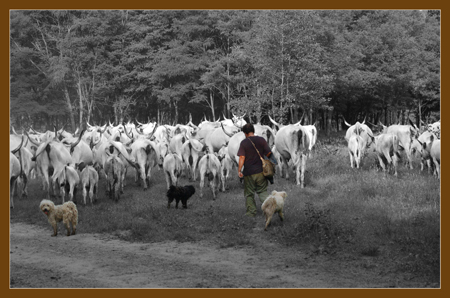
That’s why the Pumi has a much stronger relationship with the owner than with the sheep; its motivation is to please the owner. The dog has an unusually strong desire to please. Thus, a Pumi mostly works for its owner. In contrast, the Border Collie’s motivation is work, and will work practically for anyone who is familiar with the commands.
The terms “gathering” dog and “driving” dog should be interpreted slightly differently than it’s generally understood, as all herding dogs need to gather and drive. It’s not true that Hungarian herding dogs are commonly called driving dogs in colloquial language because it can only drive! It wouldn’t be too good if herding dogs only knew how to chase the stock away from the shepherd….
It’s easy to see that the Pumi called driving dog, is a good helper only when it goes out to the pasture by itself and brings the flock back to the farm. In other words, it gathers. When the herd went to market, driving was required to get the livestock on the wagon.
The term “driving “ most likely originated in ancient times, the period when the population mainly made its living from agriculture and animal husbandry. In the Trans-Danube region cattlemen frequently drove their herds consisting of several hundred Hungarian Greys 600 miles to the famous Nuremberg (Nürnberg) and other market towns in Germany. The drive with the herd, on foot and with supply wagons, assisted by herding dogs took several months.
These herding dogs drove the herd on hoof to the market, that’s why they were called “driving” dogs. During these times the Hungarian Grey Cattle was very famous. It’s credible that on these routes to the market the herding dogs of the period mixed with Western-European terriers - that’s how the contemporary Pumi breed was created in the Somogy area. The Puli or Puli type dogs were more widespread in the Hortobágy and Hungarian Lowlands.
About my training method
A few words about the training background
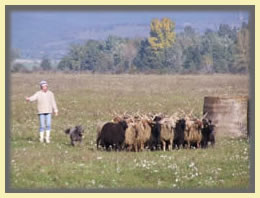 This training method consists solely of tasks that the dog can complete with its existing knowledge, and leading it to successful completion of new and more complicated tasks.
This training method consists solely of tasks that the dog can complete with its existing knowledge, and leading it to successful completion of new and more complicated tasks.
Our homepage is the only place in the world where this method can be found in written form: in the “Pumi training” section, where there is a step by step description of the correct sequence the tasks to be taught and how, illustrated with pictures. Obviously, the basic exercises must be reliably executed before more complicated tasks are taught. This is the reason that these exercises have a relatively fixed sequence.
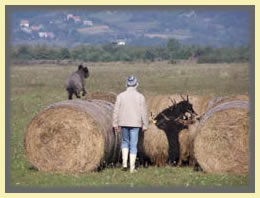 Mastering the science of herding doesn’t only consist of training the dog. It's much more complicated than that. For perfect control over a flock of sheep, both the handler and the dog must be completely familiar with the livestock’s behavior and anticipate its reactions. The owner has to anticipate the livestock’s actions to decide when to send the dog and where, or when not to send it for that matter, and where to position himself. As far as the sheep are concerned, any contact with dogs is a stressful: therefore it’s very important to keep in mind the livestock’s welfare.
Mastering the science of herding doesn’t only consist of training the dog. It's much more complicated than that. For perfect control over a flock of sheep, both the handler and the dog must be completely familiar with the livestock’s behavior and anticipate its reactions. The owner has to anticipate the livestock’s actions to decide when to send the dog and where, or when not to send it for that matter, and where to position himself. As far as the sheep are concerned, any contact with dogs is a stressful: therefore it’s very important to keep in mind the livestock’s welfare.
This knowledge can be acquired only by working with sheep, and is considered the most complicated of all dog sports.
My method is built on many years’ experience acquired by training multiple dogs and by traditions and habits learned from shepherds. Its basis is excellent dog-owner relationship. Its goal is that the dog is directed according to the owner’s individual requirements, without any outside help.
My motto is: If you work with a dog, you should always be strong enough to make the decisions, otherwise the dog will decide for you!
The instructor exists only to convey the method of teaching the task, to see the mistakes as an observer, and to help with corrections. The owner must be in sync with his dog’s stages of development, thereby strengthening their relationship. Eventually, as more experience is gained, implicit trust develops between the two parties, which is necessary to accomplish more complicated tasks.
The dog has to trust, for example if the sheep are far and invisible to the dog, because it has to believe that the sheep will be found sooner or later in the direction the handler pointed to.
The owner has to trust his dog: for example, if he sends the dog to a distant pasture which the dog can’t see, the dog will complete the task flawlessly, fetching the flock without any sheep getting hurt, straying or getting lost.
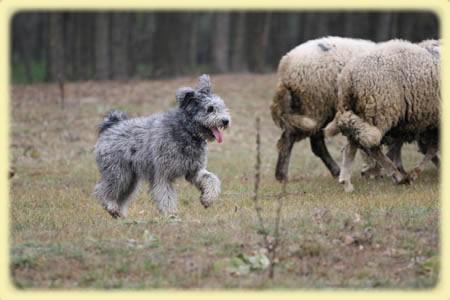
In summary, good dog-owner relationship, acquiring a stable foundation on which the thorough practice of the more complicated tasks is built, leads reliably towards serious, disciplined, accurate and cool-headed herding work.
Krisztina Menyhárt | Kondacsipkedő Team
Leányfalu, 2007.
Translated by Meir Ben-Dror
453 Dill Road, Landrum, SC 29356 USA
Email: mbendror@ws19ops.com
Phone: +1 864-313-6788
HINT: The page is printer friendly, printable in an economic, easily readable format